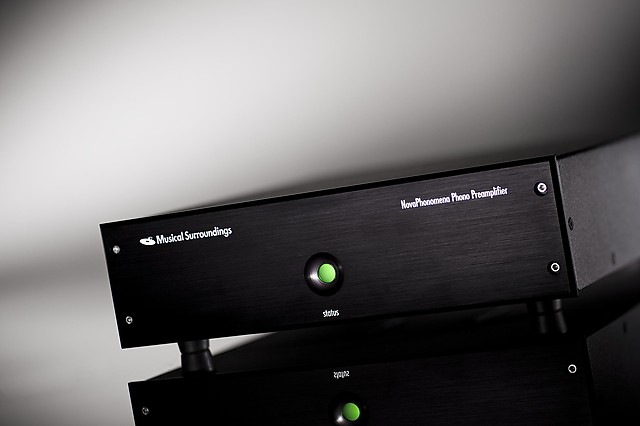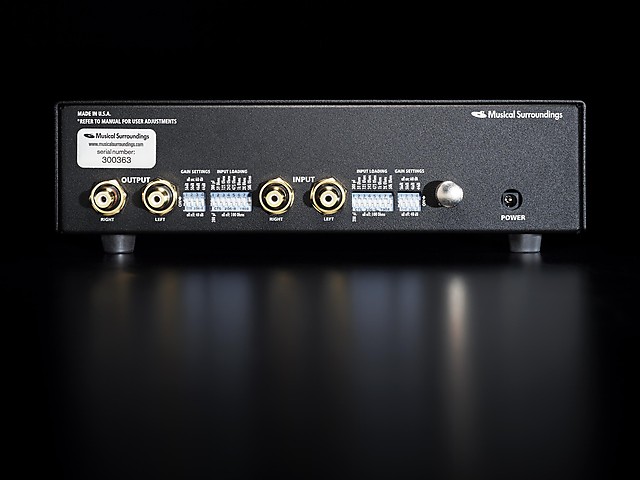Musical Surroundings Nova Phonomena Phono Preamplifier
So, you have finally purchased that turntable of your dreams. You have an arm that mates well with the turntable. You’ve carefully researched cartridge choices, and settled on one that should provide the maximum synergy with your turntable/arm combination. Unless you have a preamp or integrated amp/receiver with a dedicated built-in phono stage (something that back in the day was standard-issue, but is relatively rare in these digital days) and you’re using a moving magnet or high-output moving coil or moving iron cartridge, then your next order of business will be to acquire a proper phono stage.
In theory, this should be a pretty straightforward exercise, right? You just need a box that will properly add gain to the tiny signal generated by your cartridge, and you want the added gain to be achieved without the addition of any other noise or artifacts. But since we are in the world of hifi, the exercise is anything but straightforward. Phono stages come in so many variants (tubed, solid-state, AC-powered, battery-powered) and at so many price points (sub-$100 to $30,000-plus), and claim to offer so many advantages, that the decision can get very complicated, very quickly. Add to this that auditioning phono stages is not the easiest thing to accomplish, and you can be forgiven for throwing up your hands in frustration.
Bearing in mind the price-point question, the object of this review is the Musical Surroundings Nova Phonomena phono preamp, priced at $999. This is not chump change, certainly, but if you own a meaningful number of LPs (particularly if they are well-mastered, well-pressed, and in good condition), and assuming that you have a decent turntable and tonearm, $1,000 is not an unrealistic price point.

Nova Phonomena
Designed by Michael Yee, and manufactured in California, the Nova Phonomena occupies mid-point in Musical Surroundings’ offering of phono stages, somewhat more dear than the $600 Phonomena II, and considerably less expensive than the top-of-the-line SuperNova II (at $3,200). I might replace the term “mid-point” with “sweet spot,” since the Nova Phonomena contains technology from the SuperNova II but at a much more digestible price. The Nova’s audio circuitry is fully discrete, without op-amps, and is configured as dual mono, with separate gain and loading for each channel. Among other things, this allows the user to closely match phono output to other source levels.
There are several aspects of the Nova Phonomena that are distinctive: battery power, configurability and its “magic eyeball.” More on the eyeball later, but first to the construction and operation of this unit. The Nova Phonomena is a simple black box of modest dimensions: it is neither tiny like the Nagra BPS or the Benz Lukaschek PP-1 phono preamp, nor is it a multi-box monster like some of the five-figure units. Power is supplied by a wall wart, but the beauty of this device is how the preamp is actually powered. Inside the housing, the Nova Phonomena contains two rechargeable NiMH battery packs with what Musical Surroundings calls a “Smart Sensing” auto recharge feature. The wall wart charges the batteries, and a button on the front panel of the preamp selects whether the unit is being powered by the battery or by AC. When you switch the preamp into battery mode, AC and charging circuits automatically disconnect, with a theoretical improvement in “blackness.”
The preamp can also be used while connected to the mains with (again theoretically) a minor degradation in sound. The system is “smart” because once the batteries are fully run down (after about three hours of continuous usage), the unit will automatically switch to charging mode, even if you are listening to your turntable at the time. The transition is virtually seamless. This may make the Nova Phonomena unique among battery-powered phono preamps, which often require the AC power supply to be physically disconnected from the unit while listening.
This phono preamp is remarkably configurable. Using a series of DIP switches on the back, the user is able to select from thirteen different gain settings, ranging from 40 dB to 60 dB, and nineteen levels of input loading. On top of this, the user can set gain and loading separately for each channel. Do the math: There are hundreds of permutations of gain and loading. If there is a phono cartridge on God’s green earth that can’t be matched to this unit, I don’t know what it is.

Nova Phonomena back panel
I ran everything from a Grado Reference Sonata (5.0 mV output), Shure V-15 MxVR (3.0 mV), Sumiko Blue Point Special Evo III (2.5 mV) to a Benz-Micro Glider SL (0.4 mV) without any trouble at all. If you are a tweaker, the Nova will provide you with hours of delight, as you play with the loading switches. (Note to self: do this only when the family is out of the house.) At the highest level of gain, the unit is quite sensitive to external power sources: best to keep it well away from motors or transformers. I have limited real estate on my equipment rack, so I found that a sheet of woven mu-metal nicely isolated the Nova.
Finally, to the magic eyeball: properly called a “proximity detection switch,” this is the sole control on the front panel of the Nova. It is translucent with a green and a red LED behind it, and is activated by hovering your finger over it (very cool). When charging, this switch flashes red; when fully charged and on AC power it glows solid red; and when running on batteries only, it glows solid green. It is simple, it is elegant, it is effective.
When I listen to a phono preamp my needs are simple: I want to near nothing. Nothing at all. And this is exactly what I heard (or rather, didn’t hear) with the Nova. This preamp added nothing that I could identify to the signal coming from the vinyl. In fact, even when operating on AC power and charging the batteries, the Nova sounded superb. It was in the switch to pure battery power that the benefit of DC showed itself: the noise floor went from minimal to non-existent. I probed the depths of blackness by playing some female vocalists with minimal backing: Diana Krall, Ella Fitzgerald and Joe Pass, Sarah Vaughan, Billie Holiday. The Nova telegraphed voices gorgeously, over a pitch black background. Solo piano fared well too: George Winston’s piano on “December” emerged from the depths fully-formed and untrammeled by unwanted grain.
Larger-scale choral and orchestral works fared equally well with the Nova. Even when used with a very low-output cartridge like the Glider SL, there was no sense of compression or “stretching” on massive-sounding works like Mahler’s First Symphony or Orff’s Carmina Burana. Rock and roll fared well too, whether more laid-back tracks (James Taylor, Joni Mitchell) or full-on noise (Led Zeppelin’s “Rock and Roll” from the Classic Records—may it rest in peace—reissue, U2’s “I Still Haven’t Found What I’m Looking For”).
To sum up, it is necessary to go back to my contention at the start of this review: choosing a phono preamp ought to be a pretty straightforward decision. The good news is that the Musical Surroundings Nova Phonomena does make the decision pretty straightforward. The Nova distinguished itself more by what it didn’t do than by what it did do. It neither added nor subtracted to the music. It’s an honest broker, simply passing through signal while adding as little as possible to it. $1,000 is not an insubstantial amount to pay for something that should do nothing aside from amplify, but in this instance it is a very fair sum indeed. No phono preamp that I have used in my system (nor my preamplifier’s phono stage) comes close to the reality of the sound of the Nova Phonomena. If you are in the market for a configurable phono stage, and you’ve got a budget at this level, you would do well to audition this box.
Specifications
- Gain Switches: 40, 44, 46, 48, 50, 51.5, 52.7, 53.7, 56, 57.5, 58.4, 59.4, 60dB
- Input Loading Switches: 200pF/300pF, 30, 40, 50, 59, 80, 100, 121, 150, 243, 280, 380, 475, 660, 1k, 2k, 50k, 100k Ohms
- Discrete, dual mono circuitry
- Dimensions: 10″W x 10 7/8″D x 3″H
- Weight: 5lbs
- Warranty: 3 years
- Serial Number of Review Sample: 300072
- Retail Price: $999
Review Equipment
- VPI Classic 2 Turntable with SDS power supply
- Benz-Micro Glider SL cartridge
- Vienna Acoustics Haydn Grand SE and Gallo Reference 3.1 speakers
- McIntosh C712 preamplifier
- Yamaha MX-D1 stereo power amplifier
- Sony XDR-F1HD tuner
- Shanling SCD-T200 SACD player
- Apple iPod Classic, 160 gb
- Mapleshade speaker wire, Blue Jeans speaker cable and interconnects, Ultimate Cables, AudioQuest, ProSolutions and AR interconnects
Distributor
Musical Surroundings
5662 Shattuck Avenue
Oakland, CA 94609
www.musicalsurroundings.com




Hi Folks,
I misplaced the wall wart for my NovaPhonomena Preamplifier in the move. I need to identify what voltage and current rating it uses to find the lost one mixed with many other wall warts. Can you tell me the voltage and current requirements for this great preamp? Thanks.
Zaw Win
P/N WR9QI250LCP-N
Model GT-41076-0624
output 24v 0.25A